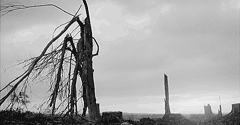Abstract
As Northern Ireland's landmark Good Friday Agreement approaches its 20-year anniversary, one site looms particularly large in the memories and perspectives of men and women who lived through the civil conflict known as the Troubles. The remains of HM Maze Prison stand unoccupied and unused while Northern Ireland debates how this polarizing historical landscape figures into the population's recovery from historical violence.
The Maze Prison/Long Kesh housed paramilitary prisoners from 1971 to 2000. A brief review of the prison history suggests that far from being placed "out of site, out of mind," its prisoners, employees, and administration retained an active role in the violence of the Troubles. Today the Maze Prison/Long Kesh serves as more than a reminder of a dark era; it is also a hotly contested cultural landscape. In the debate over the future of what remains of the prison campus, competing political perspectives have yielded proposals that prescribe drastically different approaches to the community's recovery. The prison site, perceived variably as a threat to the peace process, a minimum requirement for peace, a historical obligation, and an economic opportunity, waits in limbo for a political agreement regarding the extent to which the landscape should be put to recreational, commercial, historical, and civic use.
Creative Commons License

This work is licensed under a Creative Commons Attribution-No Derivative Works 4.0 License.
Recommended Citation
Dwiggins, Jill
(2016)
"The Troubled Past and Contested Future of Northern Ireland's Maze Prison/Long Kesh,"
Landscapes of Violence: Vol. 4:
No.
1, Article 3.
Available at:
https://scholarworks.umass.edu/lov/vol4/iss1/3
